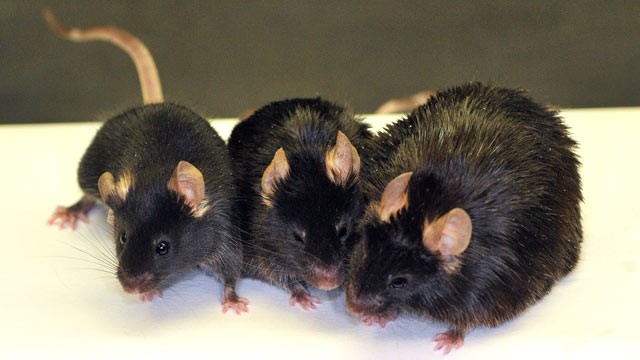
LOG- C60+olive oil on 3 mice at home: a lifespan study
#181
Posted 04 November 2012 - 12:59 PM
What are you feeding them? Fried corn flakes, full of glycation products and rancid fats. White bread-fast breakdown carbohydrates. Cheese full of cholesterol. Use nuts, sunflower seeds, whole corn, wheat, oat flakes as it is in nature. Leave that human food not to spoil the experiment.
#182
Posted 04 November 2012 - 01:16 PM
Also, if mprize at home reveals to be workable (we're doing what we can for it of course, but we'll see) then it will have a nice particularity: it will be lifespan tests in conditions that are closer to humans: instead of SPF (specific pathogen conditions) having rodent pellets, it's a pool of human homes with some variations of foods, care, temperature, rodent genetic background, etc. The ITP and Spindler's lab are already following that path when using a pool of heterogeneous mice for lifespan tests.
#183
Posted 04 November 2012 - 04:30 PM
Interesting...Lifespan varies widely with strain: for instance the one mouse who died at roughly 2 years would be in the top 15% of survivors of YBR / Eij but only the top 90% SJL/L
http://research.jax....LifeStudy2.html
Just wondering the strain so we can track how long they live versus the average - also an interesting result.

C57BL6 mice (pink here) and wistar rats (Baati et al) have similar lifespans, that what I had in mind. I bought mice in a petshop and therefore they are not of a particular strain. In France it is actually not possible for a someone outside a lab to buy a lab strain. As specified in a previous post, when asking around I was told that those who really take care of their petshop mice at home can make them live 2 years, not more as far as the answers I've had.
First time I'm hearing about the LP/J and RIII/DmMobJ mice -- wonder where they come from / what makes them naturally live so long compared no other non-short-lived strains such as C57BL6. Don't have much time right now: if someone wants to have a look great. Otherwise I'll have a look in a few days.
What it means for what I'm doing is that if my 2 mice are healthy looking in 3 months (26 months) I'll think it's probably working; in 6 months (29 months) I'll be personnally very convinced; but based on not very solid basis (!?! I could change mind, I don't know). Looking at the graph, waiting for age 32 months would be very convincing. With Mprize at home, we'll have controls so it will be better.
Edited by AgeVivo, 04 November 2012 - 04:45 PM.
#184
Posted 04 November 2012 - 07:44 PM
 bb_041112.JPG 91.62KB
36 downloads
bb_041112.JPG 91.62KB
36 downloads bw_041112.JPG 123.17KB
32 downloads
bw_041112.JPG 123.17KB
32 downloadsAdd here is a video where the black mouse with white belly did a nice stunt (The one with black belly then tried but came back after doing half of it; I keep such photos and videos in high quality format in case we want to traceback some later health outcomes)
http://agevivo.com/l...2mice041112.wmv
Edited by AgeVivo, 04 November 2012 - 08:22 PM.
#185
Posted 04 November 2012 - 07:54 PM
http://en.wikipedia....cy_mouse#Health
If so, Wikipedia says they live roughly 18-30 months depending on how they are kept and genetic predisposition (also some tips on keeping them healthy, and tick free).
So, that would fit with you idea that 30+ months is convincing.
Exciting - into the home stretch!
#186
Posted 04 November 2012 - 08:28 PM
indeed. cool wikipedia article
#187
Posted 11 November 2012 - 11:16 PM
 bw_111112.jpg 46.26KB
15 downloads
bw_111112.jpg 46.26KB
15 downloads bb_111112.jpg 45.05KB
16 downloads
bb_111112.jpg 45.05KB
16 downloads
#188
Posted 12 November 2012 - 06:27 PM
Indeed, "neoplastic": tumor. A white mass of tissue grew out of one lung. I've done autopsies (necropsies) of quite many old mice in the past, and I don't think I could be wrong on that. Whether it is the cause of death I don't know, but it seems probable.My first guess is that it died from a hemothorax due to a neoplastic lung injury.
C60, at least the water-soluble variety, has been shown to have anti-cancer activity in mice--AIM:
To estimate the impact of C(60) fullerene aqueous solution (C(60)FAS) on the rate of transplanted malignant tumor growth and metastasis.
METHODS:
Lewis lung carcinoma was transplanted into С57Bl/6J male mice. Conventional methods for the evaluation of antitumor and antimetastatic effects have been used.
RESULTS:
The C(60)FAS at low single therapeutic dose of 5 mg/kg inhibited the growth of transplanted malignant tumor (antitumor effect) and metastasis (antimetastatic effect): the maximum therapeutic effect was found to be of 76.5% for the tumor growth inhibition; the increase of animal life span by 22% was found; the metastasis inhibition index was estimated as 48%.
CONCLUSION:
It was found that water-soluble pristine С(60) fullerenes efficiently inhibit the transplanted malignant tumor growth and metastasis.
http://www.ncbi.nlm....pubmed/21956470
The blood. Water soluble fullerenes are distributed through the blood on the other hand C60 in olive oil is distributed through lymphatic system. If the tumor is encapsulated, as Zorba said, C60-OO can not get into the tumor but water solubles can. Cancer feeds on blood like a vampire.
#189
Posted 12 November 2012 - 08:18 PM
#190
Posted 12 November 2012 - 09:41 PM
#191
Posted 17 November 2012 - 09:02 PM
In 2 weeks my mice will turn 24 months, a symbol to me. I am looking at them: would you say they are old? really they do not look old. It's like having an old person doing jogging without effort and without wrinkles. Ok, they have largely lost their vibrissae, they clearly do not climb as well they used to several months ago, but look at their hair: it is really nice. And look at their shape: they don't have a curved back with no flesh: they look good. And look at how they move: not like an old mouse. Ok we don't know the strain, perhaps it is supposed to age quite late. And Ok the first mouse died. But I'm starting to believe it could well be the thing we were hoping to discover in 20 years. Perhaps after all a large part of ageing is due to some form of oxidative stress that most anti-oxydants do not tackle but that this one does. I don't have survival numbers to prove anything, but I have a feeling that something is going on, something that I was not seing with my previous mice. Anyway, my internal-scientist-resisting-mind comes back: let's see how long they live.
 2miceA_171112.JPG 51.85KB
34 downloads
2miceA_171112.JPG 51.85KB
34 downloads 2miceB_171112.JPG 162.52KB
37 downloads
2miceB_171112.JPG 162.52KB
37 downloads
#192
Posted 17 November 2012 - 09:25 PM
(I have taken 2 videos, in the other one which is after the cage change they are more active, but that other video is very dark)
About my previous post just above: if something is going on it would not necessarily be the antioxydant effect. It could be prolonged regenerative capacities of the body for example (which could be due to antioxydant or antiinflammatory properties/other)
Edited by AgeVivo, 17 November 2012 - 09:28 PM.
#193
Posted 18 November 2012 - 12:54 AM
The blood. Water soluble fullerenes are distributed through the blood on the other hand C60 in olive oil is distributed through lymphatic system. If the tumor is encapsulated, as Zorba said, C60-OO can not get into the tumor but water solubles can. Cancer feeds on blood like a vampire.
Initially, c60-oo is going to come in through the lymphatic system like other triglycerides, but eventually, after hydrolysis by lipases, the c60-fatty acid adduct is going to end up in the bloodstream.
#194
Posted 19 November 2012 - 12:13 AM
 2mice_181112.JPG 94.18KB
37 downloads
2mice_181112.JPG 94.18KB
37 downloads bw_181112.JPG 97.99KB
41 downloads
bw_181112.JPG 97.99KB
41 downloads bb_181112.JPG 74.22KB
35 downloads
bb_181112.JPG 74.22KB
35 downloads
#195
Posted 20 November 2012 - 01:40 PM
I jumped on the C60OO wagon. I'm young, but each passing day C60 looks less and less dangerous and more and more promising.
Thanks for the report and may your mice live long lives
Raphael
#196
Posted 20 November 2012 - 09:27 PM
The best one can do obviously is not to wait for results but take action on other fronts as well (@home collaborative research framework, other actiosn linked to life extension)
#197
Posted 21 November 2012 - 06:21 AM
#198
Posted 23 November 2012 - 03:57 AM
#199
Posted 23 November 2012 - 06:56 AM
#200
Posted 23 November 2012 - 07:49 AM
 (SRT1720 is given to mice on a high calorie diet. From left: mouse on standard diet, mouse on high calorie diet + SRT1720, mouse on high calorie diet and no SRT1720. Mice in second category lived 44 percent longer on average)
(SRT1720 is given to mice on a high calorie diet. From left: mouse on standard diet, mouse on high calorie diet + SRT1720, mouse on high calorie diet and no SRT1720. Mice in second category lived 44 percent longer on average)http://abcnews.go.co...71#.UK8prdesHkc
#201
Posted 24 November 2012 - 12:36 AM
#202
Posted 24 November 2012 - 09:56 PM
#203
Posted 02 December 2012 - 12:40 PM
The mice are now 24 month old and still in good shape. This only thing that let me know that they are aging is that there back starts to curl in the middle, and the hair around that place is splightly sparse. But this is very subtle compared to what I have seen in the past with other mice. And their physical activity is limited, although it is not as if they had issues moving around, far from it.
Yesterday evening I changed the cage without giving food, as usual, and this morning I fed them 4 drops of c60oo on bread, as usual, before putting food back in the cage. Here is a picture of them yesterday evening before the cage change, a picture of them this morning before the treatment, pictures of them having their treatment and a video of them before the treatment, where we see that they are still in very good shape:
 2mice_011212.JPG 43.98KB
29 downloads
2mice_011212.JPG 43.98KB
29 downloads 2mice_021212.JPG 57.29KB
36 downloads
2mice_021212.JPG 57.29KB
36 downloads
Attached Files
#204
Posted 03 December 2012 - 12:04 AM
#205
Posted 03 December 2012 - 02:24 AM
and for our testing will suffice.
#206
Posted 03 December 2012 - 04:48 AM
AgeVivo's mice are very nice,
and for our testing will suffice.
I see you are also experiencing nootropic effects from the C60!
#207
Posted 03 December 2012 - 04:04 PM
Just whatever you do don't add astaxanthin to the mix!AgeVivo's mice are very nice,
and for our testing will suffice.
I see you are also experiencing nootropic effects from the C60!
Edited by stephen_b, 03 December 2012 - 04:05 PM.
#208
Posted 03 December 2012 - 04:29 PM
#209
Posted 09 December 2012 - 01:19 AM
 mice_081212.JPG 35.21KB
26 downloads
mice_081212.JPG 35.21KB
26 downloads mice2_081212.JPG 69.19KB
29 downloads
mice2_081212.JPG 69.19KB
29 downloads
#210
Posted 09 December 2012 - 12:13 PM
Also tagged with one or more of these keywords: buckyballs, fullerenes, c60, mouse, mice, lifespan, olive oil, home, project, life extension
1 user(s) are reading this topic
0 members, 1 guests, 0 anonymous users















































